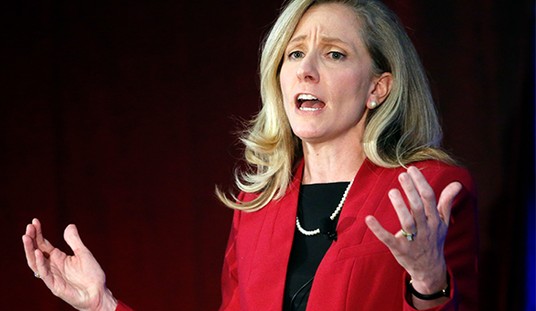By this standard, the takeout dinner I ordered on Saturday had zero cost, too … because I paid for it. And this argument might not even have that much going for it, considering how much of our federal spending comes from borrowed money. But that’s not the only dumb argument in this CNN discussion yesterday:
What idiocy. This woman is a columnist for the Washington Post. https://t.co/hoNn9pHnLo
— Brit Hume (@brithume) September 27, 2021
At one point, both Brian Stelter and Catherine Rampell try to shift the blame for the obscenely large bill to Republicans. Stelter claims that the effort to push through ridiculously large packages as an outcome of the supposedly “broken” nature of the Senate. For one thing, it’s been the urge to spend massively and make radical changes like ObamaCare and the Green New Deal that has contributed to gridlock. But Rampell goes further at one point, claiming that the bill is necessary because — I’m not kidding — it’s “partly that we no longer have majority rule in the Senate”:
STELTER: And it will be over in ten years, et cetera, et cetera. Isn’t the broader point because the Senate is broken and they don’t create laws — work on legislation all year long, they’re trying to do everything at once in one big bill.
RAMPELL: Well, it’s partly what you just mentioned, partly we no longer have majority rule in the Senate. In order to get anything through, through a party line vote, which is what theoretically should happen when we have unified control of government by the Democrats, they have to cram everything into this one major piece of legislation, so-called reconciliation bill, whatever shorthand we use for it. So, it has to cover all of the bases, or at least everything that can ostensibly get pushed into a budget bill.
STELTER: Right.
Er, when did we have “majority rule” in the Senate? Presumably this refers to the filibuster and the mechanism of cloture votes to advance to floor votes, but that’s been a practice in the Senate for well over a century. In the case of this bill in particular and its spending level, Democrats and Joe Biden don’t have a majority because it’s too much even for some of the Democrats. If they did, they would push it through on reconciliation, which is a majority-rule process for budgetary matters. It’s simply breathtaking that a reporter on such matters doesn’t comprehend any of this … and to hear it go unchallenged on a show called “Reliable Sources.”
Rampell then blames Republicans for the omnibus approach:
RAMPELL: They have to do climate. They have to do paid leave. They have to do childcare. They have to do green energy tax credits for cars and things like that. They have to put everything into this one piece of legislation because they can’t do piecemeal, regularly ordered bills because it doesn’t work that way anymore. There’s only one this narrow to get the legislation through.
STELTER: We hear it all at once and then it’s confusing and people tune out and give up and don’t pay attention at all.
None of what Rampell argues is remotely correct. If Democrats want to get an agenda through an evenly split Senate, then they need to craft it in a manner which will get at least some Republican support. Chuck Schumer controls all the committees, so he can very obviously package each policy separately. In some cases, it might have been more advisable to do so. Democrats have chosen to cram it all into one comprehensive bill in order to avoid the filibuster. Clearly, it’s not just “people” who aren’t paying any attention at all.
Anyway. The Biden administration wants to run with this “zero cost” argument, starting with The Big Guy himself:
My Build Back Better Agenda costs zero dollars.
Instead of wasting money on tax breaks, loopholes, and tax evasion for big corporations and the wealthy, we can make a once-in-a-generation investment in working America.
And it adds zero dollars to the national debt.
— President Biden (@POTUS) September 26, 2021
The $0 claim refers to the necessary deficit score to qualify for reconciliation — not costs. The deficit score depends on revenue to balance the costs, not the elimination of costs altogether. The cost of the reconciliation bill is $3.5 trillion, a number promoted by progressives as a necessary level of spending almost without regard to what is actually inside the bill itself. Even if we find revenue to cover the costs, they still remain costs — much more so than the tax cuts that Democrats deride and want to reverse to fund their pet projects, as David Harsanyi observes:
But every penny of the bill is money taken from someone, either today or tomorrow — usually from a more useful part of the economy. (Or, likely, it will be lots more debt spending. That isn’t “zero,” either, even if our political parties act like it.)
Of course, the bill also creates new baseline spending in perpetuity. There is not a single welfare-state expansion in the past century that did not undergo mission creep and near-constant growth, and none came in anywhere close to its estimate costs. Medicare was famously projected to spend $9 billion on Part A by 1990 but ended up with a $67 billion price tag.
One of the most popular criticisms of GOP tax cuts is that they “costs” us. The notion that allowing Americans to keep more of their own earnings is tantamount to government “giving” them something is specious. Tax rates were not handed to us on stone tablets, they were cooked up by legislators. The state has no claim to all your income, so it doesn’t let you “keep” anything. It can only take.
The idea that this massive spending bill has “zero costs” qualifies as gaslighting. That’s all the more true given that our spending at the federal level even before the pandemic relied on borrowing for 40% or more of it each year. That actually does have costs even apart from the spending itself — interest costs, which are rising so high that they will soon eclipse our national-security spending, if they haven’t already. There is no reason to think that this spending will get “paid for” when the federal government hasn’t paid for its annual spending through annual revenue in decades.
Will this gaslighting work? Reliable Sources, aside, Jedi mind tricks don’t work except among the weak minded.
Update: After a series of tiresome Twitter dialogues with people who either didn’t bother to read the argument or stopped at the first paragraph, I find it amusing that people think I don’t know about the filibuster. My whole argument is that the filibuster not only exists, but has existed since the 19th century. The Senate has never been a majority-rules chamber on legislation. A supermajority is not new, not even in modern times, and has been imposed by both parties on the other.
Until the last couple of decades, that reality more or less prevented both parties from advancing extreme legislation, excepting only those brief periods of time when one party controlled the White House and had a filibuster-proof majority in the Senate. (See ObamaCare, for instance.) Of late, however, both parties have decided that majoritarianism — advancing proposals that will only get votes from their own party — works better for fundraising, even if it means an inability to govern. Both parties then use the filibuster promiscuously when in the minority to stop the brute-force majoritarian bills, leading to gridlock.
Bills like this progressive spend-o-rama are the problem, not the result. That’s what Rampell gets wrong — in fact, gets it entirely backward. If Democrats wanted to pass a bill, they need to work with Republicans (and vice versa as well). The bipartisan infrastructure bill is a demonstration that the process works when both parties put governing over fundraising.
This isn’t a difficult argument to grasp.
Update: How often did Democrats require a supermajority for Senate votes in the Trump years?
After @POTUS @JoeBiden denounced the rampant abuse of the filibuster last year, we did some digging. Republicans used it once. Democrats used it 327 times. @FoxNews
— John Roberts (@johnrobertsFox) March 26, 2021
Update, 9/28 8:06 am: I doubt that the Twitter mob bothered to read any of the above, but perhaps they caught this fact check from Rampell’s own newspaper on the deficit score. Glenn Kessler gives it two Pinocchios, with options for more:
Yet even if the reconciliation bill lands with a calculated deficit impact of zero, the president will still be in a deficit hole because of the bipartisan infrastructure bill. Originally the two bills were supposed to work in tandem, but now the White House claims only the reconciliation bill represents the president’s “Build Back Better” plan. That wasn’t the story in the spring.
On top of that, given our long experience in writing about the federal budget, we’re pretty certain a deficit score of zero would only be accomplished with some dubious gimmicks that help disguise the true cost of Biden’s agenda.
We’ll keep an eye on the final outcome, but for Americans not steeped in budget arcana, the president’s claim is misleading. For now, Biden earns Two Pinocchios — a number that could grow higher.
And even if, mirabile dictu, the deficit score is zero, the bill still costs $3.5 trillion because that’s what it spends. Not zero.








Join the conversation as a VIP Member